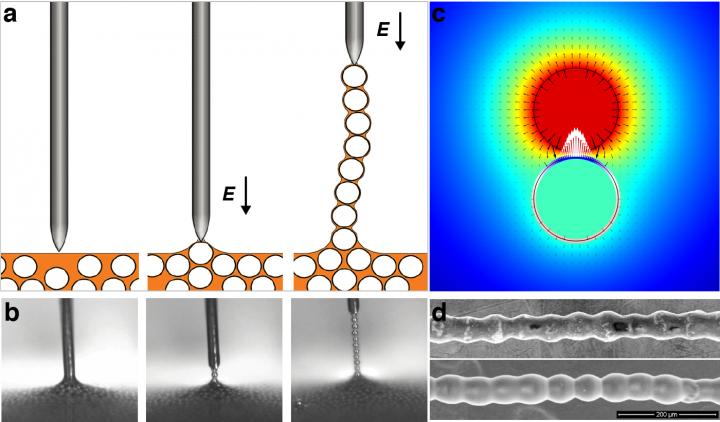International team solves mystery of colloidal chains

Particles are pulled out of a dispersion to form a 'pearl necklace', by applying an electric field through a needle-shaped electrode. Credit: Ming Han
When Northwestern Engineering's Erik Luijten met Zbigniew Rozynek, they immediately became united by a mystery.
Presenting at a conference in Norway, Rozynek, a researcher at Adam Mickiewicz University in Pozna?, Poland, demonstrated something that looked almost like magic. When he poked a needle-shaped electrode into a mixture of micron-sized, spherical metal particles dispersed in silicone oil, a sphere stuck to its end. As Rozynek pulled the electrode out of the dispersion, another sphere attached to the first sphere, and then another to the second sphere, and so on, until a long chain formed.
“The spheres behaved like magnetic beads, except no magnetism was involved,” said Luijten, professor of materials science and engineering and of engineering and applied mathematics at Northwestern's McCormick School of Engineering. “The particles have no tendency to cluster. I realized that something more complicated was happening.”
Rozynek, along with his collaborators Filip Dutka, Piotr Garstecki, and Arkadiusz Józefczak, and Luijten joined their teams to understand the phenomenon that caused these chains to form. Their resulting discovery could lead to a new generation of electronic devices and a fast, simple method to write two-dimensional electronic circuits.
“Our scientific results could open up other areas for future research — both fundamental and applied,” Rozynek said. “We are already working on follow-up projects based on our discovery.”
Supported by the Foundation for Polish Science, Polish National Science Centre, and the US National Science Foundation, the research was published online today in the journal Nature Communications. Rozynek and Luijten are co-corresponding authors. Rozynek is also co-first author with Ming Han, a PhD student in Luijten's Computational Soft Matter Lab.
Rozynek and Han performed multiple calculations, showing how the electrode's electric field changed the particles' properties. When the electrode is dipped into the colloidal solution, its charged tip polarizes each sphere. These induced dipolar interactions cause the spheres to link together. A resulting chain could contain hundreds of thousands of spheres, reaching up to 30 centimeters in length.
After the team solved the mystery of how the chains formed, it had a second mystery to tackle. “Another fascinating part is that once we pulled the chain out of the liquid, we no longer had to apply an electric field to hold the chain's structure,” Han said. “After the field was turned off, the stable particle chain remained stable.”
Following months of investigation, Luijten and Rozynek's teams discovered that the chains maintained their structures due to liquid “bridges” between adjacent particles. As researchers pulled the chain out of the liquid, silicone oil clung to the sides of each particle, forming a case around the entire chain and keeping it intact.
“Surface tension plays a big role here,” Han said. “The liquid bridge made the particles stick together. The physics here is really interesting. Most people would think that if you wanted to hold the structure, then you would need to apply the electric field. But that is not needed in our system.”
Once the flexible chain is pulled out of the liquid, it can be immediately dragged along a surface and deposited to create a pattern. The researchers believe this method could be used as an alternative way to create simple, two-dimensional electronic circuits. If molten wax is used instead of silicone oil, then the method could also be used to build three-dimensional structures that hold their shapes when the wax cools and hardens.
“Though simple, our method for fabricating colloidal structures is very elegant and can be used for many applications,” Rozynek said, “including fabrication of conductive paths on different substrates to be used, for example, in electronic applications.”
Luijten and Rozynek believe that solving this mystery could potentially open the door for applications that they cannot predict today. By understanding how the method works, they can better assess how different types of fluids or voltage levels could affect the chains and change the outcome.
“Understanding how it works makes it so much easier to manipulate and optimize,” Luijten said. “We can say if the method will work better or worse if the particles are larger or if the electric field is stronger. That's only possible because we understand it. Otherwise, you would have to examine an endless set of combinations.”
Media Contact
All latest news from the category: Physics and Astronomy
This area deals with the fundamental laws and building blocks of nature and how they interact, the properties and the behavior of matter, and research into space and time and their structures.
innovations-report provides in-depth reports and articles on subjects such as astrophysics, laser technologies, nuclear, quantum, particle and solid-state physics, nanotechnologies, planetary research and findings (Mars, Venus) and developments related to the Hubble Telescope.
Newest articles

First-of-its-kind study uses remote sensing to monitor plastic debris in rivers and lakes
Remote sensing creates a cost-effective solution to monitoring plastic pollution. A first-of-its-kind study from researchers at the University of Minnesota Twin Cities shows how remote sensing can help monitor and…

Laser-based artificial neuron mimics nerve cell functions at lightning speed
With a processing speed a billion times faster than nature, chip-based laser neuron could help advance AI tasks such as pattern recognition and sequence prediction. Researchers have developed a laser-based…

Optimising the processing of plastic waste
Just one look in the yellow bin reveals a colourful jumble of different types of plastic. However, the purer and more uniform plastic waste is, the easier it is to…


